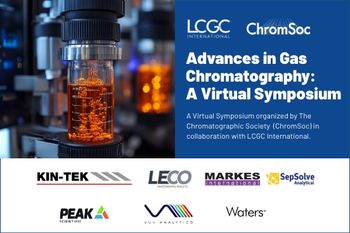
- Advances in Sample Preparation
- Volume 41
- Issue s11
- Pages: 18–21
Enhance the Performance of Solid-Phase Microextraction by Exploiting Vacuum-Assisted Headspace and Multicumulative Trapping for Olive Oil Characterization
Headspace-solid-phase microextraction (HS-SPME) is widely used for the analysis of volatile compounds from different kinds of samples.
Headspace-solid-phase microextraction (HS-SPME) is a widely used technique for the analysis of volatile compounds from different kinds of samples and with multiple fields of applications. Despite of its applicability, it can require a long extraction time and it is limited by the volatility of the analytes of interest and the need for equilibrium conditions between the sample and the headspace. Recently, two additional approaches have been proposed to reduce the extraction time and broaden the coverage to less volatile compounds, namely vacuum-assisted HS-SPME and multi-cumulative trapping HS-SPME. This paper illustrates the principle of the two techniques and their potential for extending the applicability of HS-SPME, using them as alternatives or combined to characterize olive oil samples in terms of quality.
Solid-phase microextraction (SPME), was introduced in the 1990s by Pawliszyn and collaborators (1,2), and represents one of the most widely applied techniques for volatile and semi-volatile analysis. When SPME is applied to the headspace (HS), it involves the equilibrium between three phases, and thus, two equilibrium processes—namely, the sample and the HS (characterized by Khs, distribution constant HS-sample) and the HS and the fiber (characterized by Kfh). Reaching equilibrium conditions guarantees to maximize the sensitivity. However, when dealing with complex samples and untargeted analysis, the equilibrium condition may not be reached for all the compounds within an acceptable time, and even some analytes may not be properly extracted at equilibrium conditions. Moreover, longer extraction times may promote the occurrence of a competition phenomenon (for example, displacement effect) when solid sorbents are used (3,4). Nevertheless, the direct correlation between the amount extracted (n) and the initial concentration (C0) is maintained before and at the equilibrium (equation [1]) (5):
where Vs, Vh, and Vf represent the volume of the sample, the HS, and the fiber coating, respectively.
This proportionality can also be expressed as:
where A is the chromatographic area, and ß the phase ratio (ß = Vh/Vs). This relationship is valid as long as HS saturation is avoided (6). The HS linearity range depends on the actual concentration in the sample, but also the sampling temperature, time, and ß. The linearity condition of the total sample is a compromise between trace and major components. The same compromise is necessary in terms of extraction time. To accelerate the kinetics of extraction, stirring of the sample and increased temperature are usually applied. A powerful alternative that is gaining attention is the use of vacuum-assisted HS extraction (Vac-HS). It was proposed for the first time in the early 2000s (7,8), but it has gained attention starting from 2012, thanks to the work of Psillakis and associates (9–13). Another alternative to improve the sensitivity of trace compounds using HS-SPME is to perform multiple-cumulative trapping (MCT) extractions from the same samples, thus depleting the HS of the most volatile compounds and facilitate the extraction of the less volatile compounds (14,15).
In this paper, the two aforementioned approaches, namely Vac-HS-SPME and MCT-SPME, are discussed in the context of virgin olive oil profiling.
Vacuum-Assisted HS-SPME in Fatty Samples
The fundamental theory of Vac-HS-SPME in water-based samples was nicely described in a tutorial paper published in 2017 by Psillakis and collaborators (16), and lately extended to oil based samples (17). In both cases, the use of reduced pressure does not impact the thermodynamics of the extraction but only the kinetics. It plays a fundamental role in improving the mass transfer from the sample (liquid or solid) to the HS (16,18).
To explain the limitation of the mass transfer at the interface, the two-film theory is used. This theory assumes a homogenous distribution within the bulk of each phase, while a concentration gradient is present in the stagnant thin layers at the interfaces. This theory successfully explained the behavior of volatile compounds from water-based samples when the pressure is lowered (19–21). According to this theory, the overall mass transfer coefficient, kO, at the interface can be modeled as follows:
where kG and kL are the mass transfer coefficients for the gas and liquid boundary layers, and KGL is the gas-liquid phase partition coefficient. Once in the HS, the mass transfer of the analytes to the fiber can be neglected, although it is also improved in Vac-HS-SPME (9,18,22), as shown for other high-capacity sorbents (such as, the stir bar and liquid microdrop) (23,24). Therefore, the overall resistance to transfer from liquid to the gas phase (1/kO) can be considered as two diffusional resistances in series.
The diffusion coefficient in the gas-phase, DG, has an inverse proportionality to the total pressure in the system (9). On the other hand, the liquid phase resistance is highly dependent from the viscosity of the medium (η) and the temperature (T). The Wilke-Chang (25) formula (Equation [4]) describes the diffusion coefficient in the liquid phase (DL):
where M is the molecular weight of the solvent, and V is the molar volume of the solute. Therefore, when vacuum is applied to HS-SPME, DG increases and thus kG, reducing the gas-phase resistance (see the term 1/(KGL kG) in equation 3) (9,16). However, the positive impact in extraction efficiency will be observed for analytes for which KGL is sufficiently small to have the 1/(KGL kG) term comparable or superior to the 1/kL term. KGL values for solutes in olive oil as a solvent are substantially different from those with water as a solvent, due to the differences in solute-solvent and solvent-solvent molecular interactions (26). Therefore, the use of Vac-HS- SPME for water- or oil-based samples mainly differs due to the viscosity of the two media.
Accordingly, lowering the total pressure will improve the overall mass transfer coefficient for analytes where gas-phase resistance controls their volatilization rate. It results in faster HS-SPME extraction kinetics and shorter equilibration times. However, for analytes and samples where the liquid diffusion is the limiting step (as in highly viscous medium, such as oils), the impact of reducing pressure on recoveries is less important. It plays a synergic effect with temperature, which reduces the viscosity, and thus increases DL. Figure 1 shows an example of the combined impact of reduced pressure and temperature on a series of compounds extracted from the HS of an extra virgin olive oil. In particular, semi-volatile compounds, such as for instance 2-decenal and α-farnesene, benefit significantly from the temperature increase (Figure 1). In fact, at higher temperature the increase in DL allows the analytes to rapidly reach the liquid-gas interface, and quickly replenish the HS by the facilitated mass transfer due to the reduced pressure.
In the case of water samples, a clear criterion for predicting the effect of vacuum on the extraction of the compounds of interest have been established. However, due to the limited availability of air-olive oil partitioning data (such as KGL values), and the complex interactions of solutes with olive oil, it is not possible to establish a similar criterion for oily samples.
Multiple-Cumulative Trapping HS-SPME in Fatty Samples
As previously mentioned, equilibrium may require a long extraction time to be reached. The longer the extraction time, the higher the risk of displacement effects when using a porous fiber, such as DVB/CAR/PDMS (3,27). Therefore, shorter extraction times are often preferred (also improving the throughput), but this comes at the expense of sensitivity. The payback was calculated for 49 compounds extracted from extra virgin olive oil, comparing the ratio of the responses obtained when extracting for 30 and 10 minutes (28). It was shown that the increment ranged between 0.6 to 2.6 folds, with a clear decreasing trend in uptake gain at 30 min for the less volatile analytes, which showed a ratio of about 1 (Figure 2a).
The use of MCT-HS-SPME was applied to minimize the displacement and enhance the uptake of less volatile compounds. Indeed, as shown in Figure 2b, there is a clear difference on how much better the semi-volatile compounds are extracted when performing MCT-HS-SPME with three extractions of 10 min, compared to a single extraction of 30 min.
Therefore, the use of MCT-HS-SPME proved to be advantageous in further enriching the overall information obtained from HS profiling, while maintaining the key benefit of not affecting sample throughput. This was then extended to the optimization of an additional variable: the number of repeated extractions needed to improve the information extracted (in terms of discrimination capability), but avoiding to increase the noise response, and do not modify the real perceived volatile profile. This is especially important when the intention is to determine the correlation between the volatile profile and aroma, as in the present case of olive oil analysis. It was found that repeating the extraction six times was, in fact, detrimental to differentiating between different olive oil qualities (extra virgin, virgin, and lampante) (28).
Vacuum-Assisted and Multiple-Cumulative Trapping HS-SPME in Fatty Samples
Following the previously discussed advantages of Vac- and MCT-HS- SPME, both should provide similar benefits towards the less volatile compounds. Indeed, when comparing their extraction efficiencies, similar or slightly higher responses can be observed for Vac-HS-SPME (orange bars in Figure 3, a ratio of 1 means equal response). It was decided to evaluate the combination of the two sampling approaches to evaluate the potential of further increasing the responses of the less-volatile compounds in olive oil analysis.
Preliminary tests were carried out to verify that the reduced pressure could be maintained after repeated piercing of the septum, and it proved the MCT-Vac-HS-SPME approach was feasible. Therefore 0.1 g of olive oil was extracted three times for 10 min under regular and reduced pressure conditions. For the four targeted compounds reported in Figure 3, a synergic effect can be easily observed. This is particularly true for the less volatile ones, such as 2-decenal and α-farnesene, where an increment of 4.5-5 times can be observed compared to 3-times 10 min regular pressure MCT-HS-SPME.
Cross-Sample Evaluation Using Enhanced HS-SPME
Physically extracted olive oil is classified into different commercial categories (such as extra virgin oil [EVO], virgin oil [VO], and lampante oil [LO]) based on physicochemical and sensory parameters, according to European Regulation No 2568/1991 and following modifications (29). Although the sensory evaluation is highly standardized (29,30), it presents a problem due to the inherent low robustness and reproducibility of panel evaluations. Therefore, it is clear the necessity for a robust and objective analytical method to support this classification. Moreover, this application is further complicated by the many variables affecting the aroma profile such as cultivar, geographical origin, fruit ripeness, processing practices, and storage conditions.
Although there is a clear enhanced response of the less volatile compounds by the implementation of reduced pressure conditions (in particular for MCT), this required further evaluation to determine whether it reflects in a gain of overall information obtained from the volatile profile, especially for olive oil. This was preliminary tested in a study consisting of about 70 samples of olive oil of different quality and geographical origins (Italy, Spain-Portugal, Spain, Spain-Tunisia, and Tunisia) using MCT-HS-SPME-GC–MS (31). As it can be observed in Figure 4, the higher quality EVO (blue dots on the left side of Figure 4) were clearly differentiated from the samples that presented some sensory defects (VO and LO, reddish dot on the left side of the top principal component analysis [PCA]). At first glance, it may be seen as the proposed approach does not allow for discrimination between the VO and LO. However, when adding PC3 (here emphasized with a hierarchical cluster analysis) there was a satisfactory discrimination between VO and LO. Although some misclassifications occurred, it has to be kept in mind that the classification into LO can also be related to chemical parameters, such as the acidity or the peroxide value. Thus, the sensory defects may not be the only thing responsible for the classification.
Moreover, EVO samples could be further classified based on the geographical origin of the olives. Italian and Spanish oils were very clearly discriminated, as well as Tunisian ones, although only very few samples were available. Unfortunately, no pure Portugal samples were available, and the Tunisian ones were too few to provide enough statistical power to differentiate the mixtures. Nevertheless, their content in the mixtures was far less than 10% of these different origins, thus justifying their clustering with the Spanish EVO.
The implementation of combined MCT-Vac-HS-SPME was also extended to the use of a multidimensional comprehensive GC (GC×GC)–MS separation. The combination of the more powerful separation technique (GC×GC), and the enrichment during sampling, provided a very satisfactory separation of the three groups of olive oil (EVO, VO, and LO). This very good classification obtained with MCT-Vac-HS-SPME is shown in Figure 5.
Conclusions
Vac-HS-SPME and MCT-HS-SPME are two useful alternative techniques that can be used on their own or combined to enhance the profiling of volatile and semi-volatile compounds. The two techniques can be easily implemented and have both shown a significant improvement in the recovery of the semi-volatile compounds. Moreover, if coupled to GC×GC, the enriched extraction profiles can be more comprehensively separated, allowing for a substantial improvement of the discrimination ability among olive oil samples of different quality (that is, EVO, VO and LO) based on the information rich chromatographic fingerprints obtained.
Acknowledgments
This article is based upon work from the Sample Preparation Study Group and Network, supported by the Division of Analytical Chemistry of the European Chemical Society.
Note
The authors declare no competing financial interest.
References
(1) Zhang Z.; Pawliszyn, J. Headspace Solid-Phase Microextraction. Anal. Chem. 1993, 65 (14), 1843–1852. DOI:
(2) Pawliszyn, J. Theory of Solid-Phase Microextraction. J. Chromatogr. Sci. 2000, 38, 270–278 (2000). DOI:
(3) Górecki, T.; Yu, X.; Pawliszyn, J. Theory of Analyte Extraction by Selected Porous Polymer SPME Fibres. Analyst 1999, 124 (5), 643–649. DOI:
(4) Gionfriddo, E.; Souza-Silva, É. A.; Pawliszyn, J. Headspace Versus Direct Immersion Solid Phase Microextraction in Complex Matrixes: Investigation of Analyte Behavior in Multicomponent Mixtures. Anal. Chem. 2015, 87 (16),8448–8456 (2015). DOI:
(5) Pawliszyn, J. Handbook of Solid Phase Microextraction, First Ed; Elsevier Inc., 2012.
(6) Kolb, B.; Ettre, L. E. Static Headspace-Gas Chromatography: Theory and Practice Choice Rev. Online; Wiley-VHC, 2006). DOI:
(7) Brunton, N. P.; Cronin, D. A.; Monahan, F. J. The Effects of Temperature and Pressure on the Performance of Carboxen/PDMS Fibres During Solid Phase Microextraction (SPME) of Headspace Volatiles from Cooked and Raw Turkey Breast. Flavour Fragr. J. 2001, 16 (4), 294–302. DOI:
(8) Darrouzès, J.; Bueno, M.; Pécheyran, C.; Holeman, M.; Potin-Gautier, M. New Approach of Solid-Phase Microextraction Improving the Extraction Yield of Butyl and Phenyltin Compounds by Combining the Effects of Pressure and Type of Agitation. J. Chromatogr. A 2005, 1072 (1), 19–27. DOI:
(9) Psillakis, E.; Yiantzi, E.; Sanchez-Prado, L.; Kalogerakis, N. Vacuum-Assisted Headspace Solid Phase Microextraction: Improved Extraction of Semivolatiles by Non-Equilibrium Headspace Sampling Under Reduced Pressure Conditions. Anal. Chim. Acta 2012, 742, 30–36. DOI:
(10) Psillakis, E.; Mousouraki, A.; Yiantzi, E.; Kalogerakis, N. Effect of Henry's Law Constant and Operating Parameters on Vacuum-Assisted Headspace Solid Phase Microextraction. J. Chromatogr. A 2012, 1244, 55–60. DOI:
(11) Psillakis, E.; Yiantzi, E.; Kalogerakis, N. Downsizing Vacuum-Assisted Headspace Solid Phase Microextraction. J. Chromatogr. A 2013, 1300, 119–126. DOI:
(12) Yiantzi, E.; N. Kalogerakis, N.; Psillakis, E. Design and Testing of a New Sampler for Simplified Vacuum-Assisted Headspace Solid-Phase Microextraction. Anal. Chim. Acta 2016, 927, 46–54. DOI:
(13) Trujillo-Rodríguez, M. J. et al., Vacuum-Assisted Headspace-Solid Phase Microextraction for Determining Volatile Free Fatty Acids and Phenols. Investigations on the Effect of Pressure on Competitive Adsorption Phenomena in a Multicomponent System. Anal. Chim. Acta 2017, 962, 41–51. DOI:
(14) Oliver-Pozo, C.; Trypidis, D.; Aparicio, R.; Garciá-González, D. L.; Aparicio-Ruiz, R.Implementing Dynamic Headspace with SPME Sampling of Virgin Olive Oil Volatiles: Optimization, Quality Analytical Study, and Performance Testing. J. Agric. Food Chem. 2019, 67 (7), 2086–2097. DOI:
(15) Chin, S. T.; Eyres, G. T.; Marriott, P. J. Cumulative Solid Phase Microextraction Sampling for Gas Chromatography-Olfactometry of Shiraz Wine. J. Chromatogr. A 2012, 1255, 221–227 (2012). DOI:
(16) Psillakis, E. Vacuum-Assisted Headspace Solid-Phase Microextraction: A Tutorial Review. Anal. Chim. Acta 2017, 986, 12–24. DOI:
(17) Mascrez, S.; Psillakis, E.; Purcaro, G. A Multifaceted Investigation of the Effect of Reduced Pressure Condition on the Headspace-Solid Phase Microextraction of Extra-Virgin Olive Oil. Anal. Chim. Acta 2020, 1103, 106-114. DOI:
(18) Górecki, T. Effect of Sample Volume on Quantitative Analysis by Solid-phase Microextraction Part 1. Theoretical Considerations. Analyst 1997, 122 (10), 1079–1086. DOI: 10.1039/A701303E
(19) Chao, H.-P. Volatilization Characteristics of Organic Solutes in Stirred Solution. J. Environ. Manage. 2009, 90 (11), 3422–3428. DOI:
(20) Mackay, D.; Wolkoff, A. W. Rate of Evaporation of Low-Solubility Contaminants from Water Bodies to Atmosphere. Environ. Sci. Technol. 1973, 7 (7), 611–614. DOI:
(21) Mackay, D.; Yuen, T. K.Volatilization Rates of Organic Contaminants from Rivers. Water Qual. Res. J. 1980, 15 (1), 83–201. DOI:
(22) Koziel, J.; Jia, M.; Pawliszyn, Air Sampling with Porous Solid-Phase Microextraction Fibers. J. Anal. Chem. 2000, 72 (21), 5178–5186. DOI:
(23) Solomou, N.; Bicchi, C.; Sgorbini, B.; Psillakis, E. Vacuum-Assisted Headspace Sorptive Extraction: Theoretical Considerations and Proof-of-Concept Extraction of Polycyclic Aromatic Hydrocarbons from Water Samples. Anal. Chim. Acta 2020, 1096, 100–107 (2020). DOI:
(24) Psillakis, E.; Koutela, N.; Colussi, A. J. Vacuum-Assisted Headspace Single-Drop Microextraction: Eliminating Interfacial Gas-Phase Limitations. Anal. Chim. Acta 2019, 1092, 9–16 (2019). DOI:
(25) Wilke, C. R.; Chang, P. AIChE J. 1955, 1 (2), 264–270. DOI:
(26) Schwarzenbach, R. P.; Gschwend, P. M.; Imboden, D. M. Environmental Organic Chemistry, Second Edition; John Wiley & Sons Inc., 2003.
(27) Trujillo-Rodríguez, M. J. et al. Vacuum-Assisted Headspace-Solid Phase Microextraction for Determining Volatile Free Fatty Acids and Phenols. Investigations on the Effect of Pressure on Competitive Adsorption Phenomena in a Multicomponent System. Anal. Chim. Acta 2017, 962, 41–51. DOI:
(28) Mascrez, S.; Purcaro, G. Enhancement of Volatile Profiling Using Multiple-Cumulative Trapping Solid-Phase Microextraction. Consideration on Sample Volume. Anal. Chim. Acta 2020, 1122, 89–96. DOI:
(29) European Commission Regulation No 2568/1991, Commission Regulation (EEC) No 2568/91 of 11 July 1991 on the Characteristics of Olive Oil and Olive-Residue Oil and on the Relevant Methods of Analysis. Off. J. Eur. Comm. 1991, 69 (2568).
(30) IOC, Int. Olive Counc. (15) (2018).
(31) Spadafora, N. D.; Mascrez, S.; McGregor, L.; Purcaro, G. Exploring Multiple-Cumulative Trapping Solid-Phase Microextraction Coupled to Gas Chromatography–Mass Spectrometry for Quality and Authenticity Assessment of Olive Oil. Food Chem. 2022, 383, 132438. DOI:
Steven Mascrez and Giorgia Purcaro are with Gembloux Agro-Bio Tech, at the University of Liège, in Gembloux, Belgium. Juan Aspromonte is with the Laboratorio de Investigación y Desarrollo de Métodos Analíticos at the Universidad Nacional de La Plata, in La Plata, Argentina. Direct correspondence to:
Articles in this issue
about 2 years ago
Recent Advances and Applications of Passive Sampling DevicesNewsletter
Join the global community of analytical scientists who trust LCGC for insights on the latest techniques, trends, and expert solutions in chromatography.





